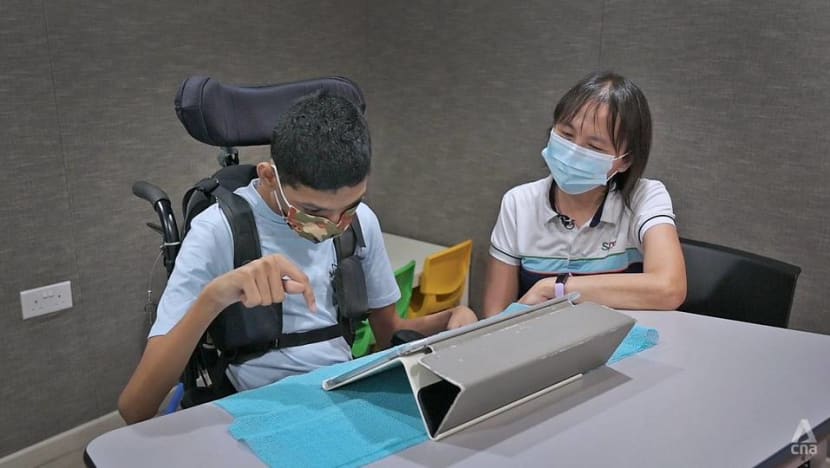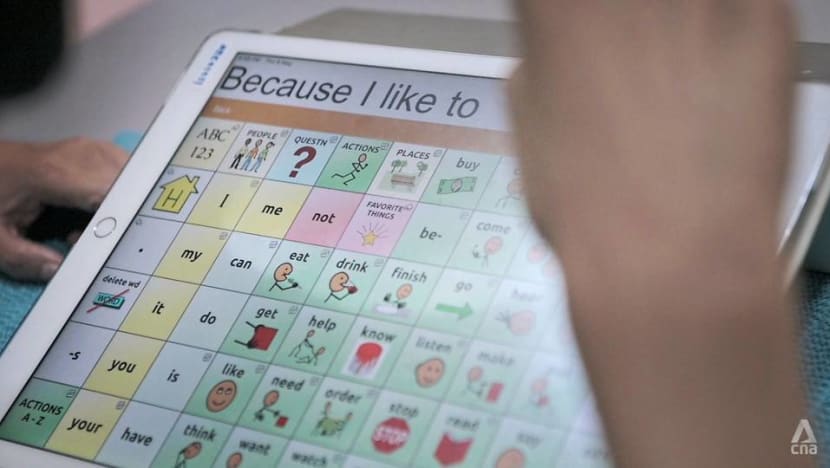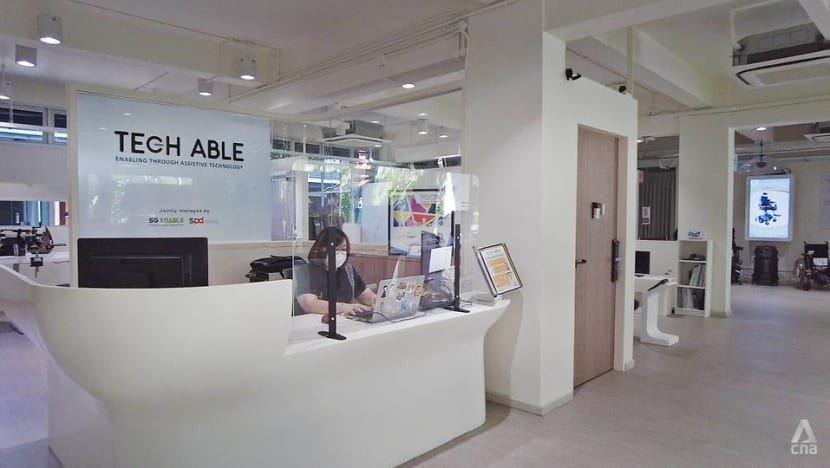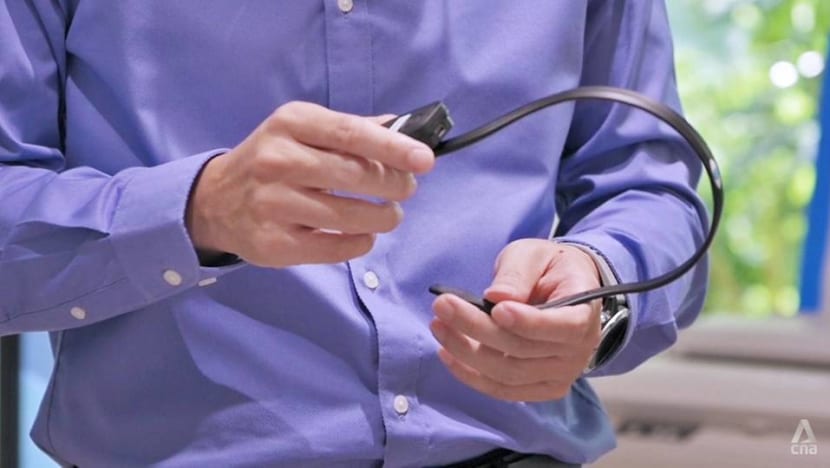‘With technology, sky’s the limit’: How smart devices can help people with disabilities live independently

Sayfullah and SPD's Ms Sarah Yong converse through Sayfullah's iPad. (Photo: Hanidah Amin)
SINGAPORE: As a digital artist, Mohd Sayfullah knows that getting exposure online is important. That is why he mentions his Instagram art account when he introduces himself to others - except, it is no ordinary greeting.
Sayfullah uses an iPad to communicate as he has a speech impairment.
A few taps on the device is all it takes to summon a male voice, programmed to say: "My name is Sayfullah. I will be 18 years old. I attend school at Cerebral Palsy Alliance Singapore, CPAS.
"I’m a junior lab artist. I do digital art using Microsoft Powerpoint. Follow me on my creative and digital art journey on Instagram at artbysayfullah.”
Diagnosed with spastic quadriplegic cerebral palsy, which gives him moderate uncontrollable upper limb movements, Sayfullah's speech impairment made it difficult for him to communicate with the people around him.

“Whenever we had a conversation, it’s between us, yes mum and son conversation, I can understand him,” his mother and caregiver Mdm Fadillah told CNA. “But what happens if there’s another person who wants to strike a conversation with him?”
Once, when the two of them attended an event at Jurong Bird Park, Sayfullah was asked for his name and his age. Although he replied, people could not seem to understand him and asked the same question three or four times, said Mdm Fadillah.
The repeated questions frustrated Sayfullah, and Mdm Fadillah had to step in to answer.
“I have to be the third voice,” said Mdm Fadillah. “I find that as time goes by, it is increasingly difficult for people to understand his language, and I have to be there constantly to answer him and talk for him. So that’s where I guess I have to do something.”
They started with picture cards to help Sayfullah express his thoughts. But the cards were bulky, and as Sayfullah’s vocabulary grew, they realised that they needed a better communication system.
After deciding that an iPad with specialised software would fit Sayfullah’s needs best, they sought help from SPD, a local charity that supports people with disabilities.
THE FITTING PROCESS
Tech Able, an assistive technology centre, provides a range of devices to help people with disabilities, working with their clients to find a suitable solution for their needs.
A joint initiative by SPD and SG Enable, it is located at the Enabling Village. The centre includes an assessment centre, an assistive device library and a smart home and office technology showcase.
This is where Sayfullah and his mother met Ms Sarah Yong, the clinical head at SPD's Specialised Assistive Technology Centre.
“When Sayfullah first came in, you could see that he was a young man that had a lot of things to say,” Ms Yong said. “Can see it in his eyes - he really wanted to engage people. And he was actually speaking verbally, but he was very difficult to be understood."
Through her interactions with Sayfullah, she learned that he had a “pretty good” command of the language, and so he needed a tool with a “robust” language and vocabulary system. They also decided on a device with voice output, to allow Sayfullah to interact with people around him.
READ: Singapore unveils plans to provide people with disabilities with customised job coaching
READ: This startup wants to help differently abled people stay employed
There were other considerations. Would he use it with his hands or his eyes? Would he need a switch? Where would they position the device?
“We also needed to think about him and how we were going to train him,” said Ms Yong.
“Initially, an individual may be prescribed with the communication device, but because of years and years of not communicating with people, they might not realise that they actually have something to say.”
With all that in mind, they settled on an iPad with software that allows Sayfullah to choose his words from a variety of options, before playing it out as a full sentence.
As Sayfullah needed to use the computer, the specialists also looked into fitting him with an alternative mouse that would suit his needs.
Clients tend to be referred to them through hospitals, schools, a friend or a caregiver or walk-ins, said Ms Yong.
“So we will look at the referral information, and then we will think about what would be the best team of assistive technology professionals and specialists that would conduct the assessment.”

Tech Able’s 18-strong assistive technology team is interdisciplinary, said Ms Yong. They include occupational therapists, speech therapists, engineers and an educator.
“We believe in having this interdisciplinary team because it really enables us to assess the client from many different angles and look at many different aspects, so we can give a very good solution,” she said.
Assessors will look at clients’ strengths, weaknesses and preferences. Then they will assess their language and motor skills, their environments, where they will use the technology and the tasks they would need to perform.
TYPES OF ASSISTIVE TECHNOLOGY
Tech Able’s devices can help people with physical disabilities, sensory disabilities such as deafness and visual impairment, intellectual disabilities and autism, said Mr Ron Loh, director of Enablers Development at SG Enable.
The Enablers Development team works with organisations on projects to improve accessibility at work, schools or on transport. This could involve installing wheelchair ramps, or placing tactile designs on the floor for people with visual impairment.
The challenges that the disability community face are “quite varied”, and it is important to apply the most appropriate solution, said Mr Loh. This means that Tech Able’s assessors do not insist on the most "high-tech" or innovative technology, but the most affordable and accessible device for the client.

Some examples of assistive technology available at Tech Able include the Quha Gyroscopic Mouse, the Phonak Roger Pen and Mylink, as well as Augmentative and Alternative Communication devices.
The gyroscopic mouse can be attached to any part of the user’s body, such as the head, the wrist or the foot, allowing people with physical disabilities to access the computer without using a traditional mouse.
The Phonak Roger Pen and MyLink is a wireless microphone and receiver. The microphone, shaped like a pen, can be pointed at any source of sound, transmitting it to the user’s hearing aids. It can be used at a distance and allows those who are hard-of-hearing to hear better while minimising background noise.
Augmentative and Alternative Communication tools help people who face difficulties communicating with others. It can take the form of picture communication books, or customisable software in smart devices, just like the one used by Sayfullah.
Before clients make their purchases, they can loan the device for a nominal fee, said Mr Loh.
For people who may need financial assistance, SG Enable offers an Assistive Technology Fund providing subsidies of up to 90 per cent of the cost of the device.
“We believe that in the appropriate use of assistive technology, it could greatly reduce the barriers of inclusion for persons with disabilities, be it during their work, studies or in their daily living,” he said, adding that Tech Able has supported more than 1,300 people with disabilities for their assistive technology needs so far.

Such devices have made a world of difference for clients like Sayfullah.
The iPad has boosted his confidence, said Mdm Fadillah. “He is able to call people, even strangers. He’s able to state his preferences clearly. And when we go out, I don’t have to be the third voice anymore.”
When asked if she sees a situation where Sayfullah could live independently, Mdm Fadillah said: “Definitely.”
While she still has to push him around in his wheelchair, she hopes that eventually, he will be able to use a motorised wheelchair to get around by himself.
This will allow him to be independent, “to move for himself, to talk for himself”, she said. “He has the desire to be like a normal teenager, to watch movies by himself.”
As assistive technology specialists, the challenge is really to help individuals “maximise their potential”, said Ms Yong.
“(It’s about) seeing the potential, considering the possibilities and really considering their dreams so that we can help the client really maximise their potential, do what they have always wanted to do … With technology, the sky’s the limit.”
Watch this video to learn more about Sayfullah's speech journey:
Editor's note: This article has been updated to correct the number of people in Tech Able’s assistive technology team after the organisation amended the information provided to CNA in the interview..












